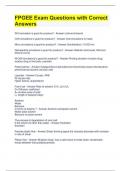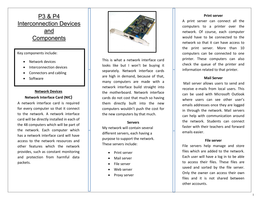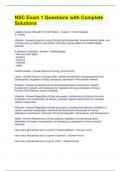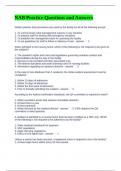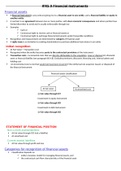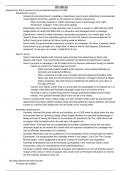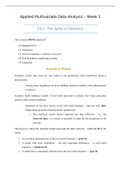Notes Intro to Safety and Secrity
Session 1: SSMS and What it’s All About
Course Learning goals: Three worlds of SSMS:
- Logic of SSMS - Public Safety
- Multidisciplinary view - Industrial Safety/Corporate Security
- Understanding SSMS domains - International Security
- Learn to solve problems
- Apply learned knowledge and skills in
different environments
- Understand importance of SSMS
Safety = unintentional harm
- Natural disasters, accidents, etc.
Security = intentional harm
- Crime, deliberate activities, etc.
The difference is the element of human intentionality.
Types of Safety and Security:
Physical Safety: extent to which people are protected and feel protected against personal harm
caused by accidents and against calamities of non-human origin.
Industrial Safety: prevention or reduction of threats for one's business, its employees or
environment due to natural risks (for instance flooding) and risks connected with production
processes or logistics.
Public Security: extent to which people are protected and feel protected against personal harm due
to crime, offenses and harassment by other people.
Security (Corporate, Cyber, Regional): prevention or reduction of malicious infliction of damage on
citizens, employees, and public and private assets.
Risk Evaluation:
Risk = possibility of an adverse future event, multiplied by its impact or the uncertainty of the
outcome. Risks used to be natural, small scale and unequally distributed, but are now manmade,
large scale, political and equally distributed.
Risk Decision:
Tolerate the risk – continue to monitor but implement no additional measures at this stage
Treat the risk – to reduce the likelihood and/or impact
Terminate the risk – do not start or continue that activity that gives rise to the risk
Transfer the risk – either escalate the risk or share some of the risk with another organisation
What SSMS professionals do:
Manage risks in a state of insecurity.
- Identify and assess risk situations = risk analyses
- Design and recommend feasible safety and security interventions
, - Implement and coordinate safety and security interventions based on information
- Evaluate safety and security interventions and solutions
Session 2: Safety and Security Intervention
Intervention: getting involved, deescalating
Options for intervention: Preparation:
- Prevention - prepare for action when things (are about
- Preparation to) go wrong
- Repression - training, drills, maintenance, plans
- Recovery
Repression:
- Proaction
- Intervention to stop an unsafe/insecure
Proaction: situation and limit damage
- Eliminating structural & systemic causes - Arrests, firefighting, evacuation, kill enemy
- (Spatial)design, education
Recovery:
Prevention: - Return to normality
- Precautionary measures, being prepared - Aftercare, damage reduction, learning->
- Locks, alarms, security checks, PPE, cameras evaluate
Road to boom: by intervening you can minimize
BOOM!
the impact of an adverse event.
Escalation
BOOM!
Time
With intervention Wihout intervention
Terrorism: could be any type of crisis or disaster, i.e. fire, explosion, plane crash, disease etc.
Three factors:
Human:
- People have to adapt
- Increased convergence and cooperation of people and organisations
- Generally little panic/irrational behaviour
- Existing conflicts will subside
- Fear of terrorism may cause a shift to stereotyping, polarisation and discrimination
Fear:
- May change public attitudes
- Survival mechanism
- Vulnerability to overreaction
- May add to damage
Resilience:
- Countertrend to vulnerability
- Asses and contribute meaning to threats
- Can be increased
Session 1: SSMS and What it’s All About
Course Learning goals: Three worlds of SSMS:
- Logic of SSMS - Public Safety
- Multidisciplinary view - Industrial Safety/Corporate Security
- Understanding SSMS domains - International Security
- Learn to solve problems
- Apply learned knowledge and skills in
different environments
- Understand importance of SSMS
Safety = unintentional harm
- Natural disasters, accidents, etc.
Security = intentional harm
- Crime, deliberate activities, etc.
The difference is the element of human intentionality.
Types of Safety and Security:
Physical Safety: extent to which people are protected and feel protected against personal harm
caused by accidents and against calamities of non-human origin.
Industrial Safety: prevention or reduction of threats for one's business, its employees or
environment due to natural risks (for instance flooding) and risks connected with production
processes or logistics.
Public Security: extent to which people are protected and feel protected against personal harm due
to crime, offenses and harassment by other people.
Security (Corporate, Cyber, Regional): prevention or reduction of malicious infliction of damage on
citizens, employees, and public and private assets.
Risk Evaluation:
Risk = possibility of an adverse future event, multiplied by its impact or the uncertainty of the
outcome. Risks used to be natural, small scale and unequally distributed, but are now manmade,
large scale, political and equally distributed.
Risk Decision:
Tolerate the risk – continue to monitor but implement no additional measures at this stage
Treat the risk – to reduce the likelihood and/or impact
Terminate the risk – do not start or continue that activity that gives rise to the risk
Transfer the risk – either escalate the risk or share some of the risk with another organisation
What SSMS professionals do:
Manage risks in a state of insecurity.
- Identify and assess risk situations = risk analyses
- Design and recommend feasible safety and security interventions
, - Implement and coordinate safety and security interventions based on information
- Evaluate safety and security interventions and solutions
Session 2: Safety and Security Intervention
Intervention: getting involved, deescalating
Options for intervention: Preparation:
- Prevention - prepare for action when things (are about
- Preparation to) go wrong
- Repression - training, drills, maintenance, plans
- Recovery
Repression:
- Proaction
- Intervention to stop an unsafe/insecure
Proaction: situation and limit damage
- Eliminating structural & systemic causes - Arrests, firefighting, evacuation, kill enemy
- (Spatial)design, education
Recovery:
Prevention: - Return to normality
- Precautionary measures, being prepared - Aftercare, damage reduction, learning->
- Locks, alarms, security checks, PPE, cameras evaluate
Road to boom: by intervening you can minimize
BOOM!
the impact of an adverse event.
Escalation
BOOM!
Time
With intervention Wihout intervention
Terrorism: could be any type of crisis or disaster, i.e. fire, explosion, plane crash, disease etc.
Three factors:
Human:
- People have to adapt
- Increased convergence and cooperation of people and organisations
- Generally little panic/irrational behaviour
- Existing conflicts will subside
- Fear of terrorism may cause a shift to stereotyping, polarisation and discrimination
Fear:
- May change public attitudes
- Survival mechanism
- Vulnerability to overreaction
- May add to damage
Resilience:
- Countertrend to vulnerability
- Asses and contribute meaning to threats
- Can be increased

